Lords of Waterdeep didn’t need an expansion, or did it? Read on to get Tom’s take on Scoundrels of Skullport!
The year after Wizards of the Coast released the Lords of Waterdeep board game, they followed it up with the Scoundrels of Skullport expansion. Scoundrels of Skullport adds more of everything you’d expect: more cards, more Buildings, and more locations to place Agents.
It also introduces a new facet to the game: Corruption. This new element is so central to the Skullport part of this expansion that I’ve given it its own section, so read on.
If you’re not familiar with how Lords of Waterdeep is played, may I recommend you take a look at my review of the base game here on Meeple Mountain? I’ll wait while you read that review.
Back? Great. Let’s carry on then.
Despite this not being a true D&D game (you’re headhunters for a recruitment firm trying to get the right combination of Adventurers to send out on Quests), my group and I like Lords of Waterdeep for the tight worker placement game that it is.
Let’s look at what’s in this expansion, shall we?
New Cards, New Buildings
As a card-driven game, it’s no surprise that this expansion comes with new Intrigue and Quest cards—50 new Intrigue cards…
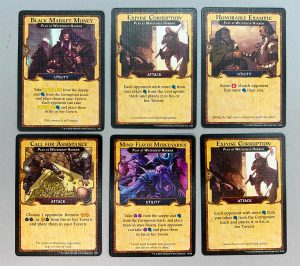
…and 60 new Quest cards, to be exact, thus doubling the number of cards in each category.
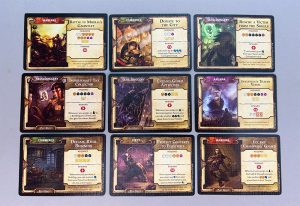
And while many of these have to do with the new Corruption element, there is one important addition to the Quest cards. In Lords of Waterdeep, the most points you could score by completing a Quest card was 25 points, with a rough average for most Quests of 10 points. This expansion introduces five Quests worth a whopping 40 points. These cards require a lot of Adventurers to complete but are always scooped up as soon as one of my group sees them in Cliffwatch Inn.
With 24 new buildings, the number of available buildings for Builder’s Hall also doubles. Again, some feature Corruption, but others offer substantial amounts of money or Adventurers.
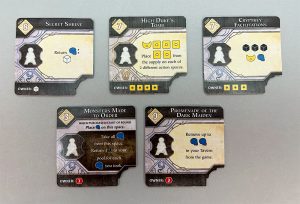
By doubling the cards and buildings, the replayability of Lords of Waterdeep more than doubles.
Playing Boards
While the rule book states the expansion is divided into two distinct modules, there was never any question that we’d do anything but play them together.
Scoundrels of Skullport includes two small playing boards, one for each module: Undermountain and Skullport. Each of these has three new buildings to send Agents. In Undermountain you have:
- Entry Well, where you can claim a Quest and take an Intrigue card.
- Hall of Mirrors, where you can either claim a single Cleric or a Fighter and a Rogue.
- The Grim Statue, where you can take two Intrigue cards.
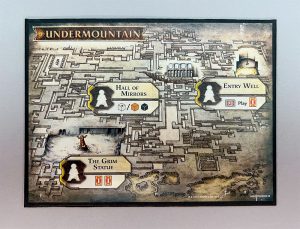
The Skullport board has:
- Hall of the Voice, where you can claim a Quest and Intrigue card, along with five gold coins, at the price of an added Corruption.
- Slavers’ Market, where you recruit two Fighters and two Rogues, at the price of an added Corruption
- Skull Island, where you can recruit two Adventurers of your choosing, at the price of an added Corruption
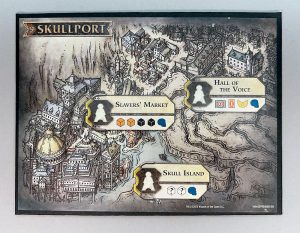
Players assign Agents to these buildings just as they would for any building on the main playing board.
Corruption
So, what is this Corruption I keep mentioning?
At its simplest, each Corruption you have at the end of the game will earn you negative points. How many negative points each Corruption is worth depends on how much Corruption has been removed from the Skullport Corruption Track.
The Corruption Track starts with a single Corruption skull in the area marked -1 and three Corruption skulls on each of the other areas, marked -2 through -7. If the game ends and you have the only Corruption skull, it’s only worth -1 point. Not bad, right?
The catch is, of course, with Corruption being so tempting throughout the game, it’s likely that other players will take on Corruption as well. And each time they do so, the negative cost of that Corruption increases. For example, if you end the game with five Corruption and the -1 through -5 areas are empty, each of your Corruption skulls are worth -6 points, for a total of -30 points.
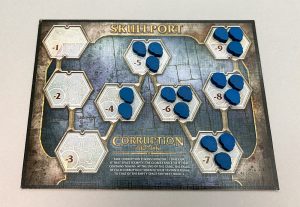
There are cards and Buildings that grant you a combination of coins, Adventurers, and Corruption. Other cards and Buildings allow you to rid yourself of Corruption by returning your skulls back to the Corruption Track.
Is it Worth It?
Lords of Waterdeep is a fine game unto itself. It’s not ‘broken’ the way some games require an expansion to balance out and correct issues the original game had. (Shipwrights of the North Sea anyone?)
When a base game is good, I’m inherently suspicious of expansions. Is the expansion worth buying? Or is it just a way for the publisher to capitalize on a $uccessful game?
Within our first turns with the Scoundrels of Skullport expansion, we caught on to how the additions were changing the game, making it that much better. The Corruption Track adds a new level of complexity to Lords of Waterdeep, one that my gaming group and I really like.
The Corruption Track brings an added tension to decisions throughout the game—especially in the final rounds. Is taking a(nother) Corruption worth the points you can score with all the good things that come with it? How much, if any, Corruption can you get rid of before the end of the game? And how much Corruption do your opponents have?
The Scoundrels of Skullport expansion is now a permanent addition to our games of Lords of Waterdeep. In discussing this with my group, none of us can imagine playing the game without it now.
If you enjoy Lords of Waterdeep but haven’t added the Scoundrels of Skullport, I wholeheartedly encourage you to consider doing so. I think you, like me, will find that it makes a good game even better.


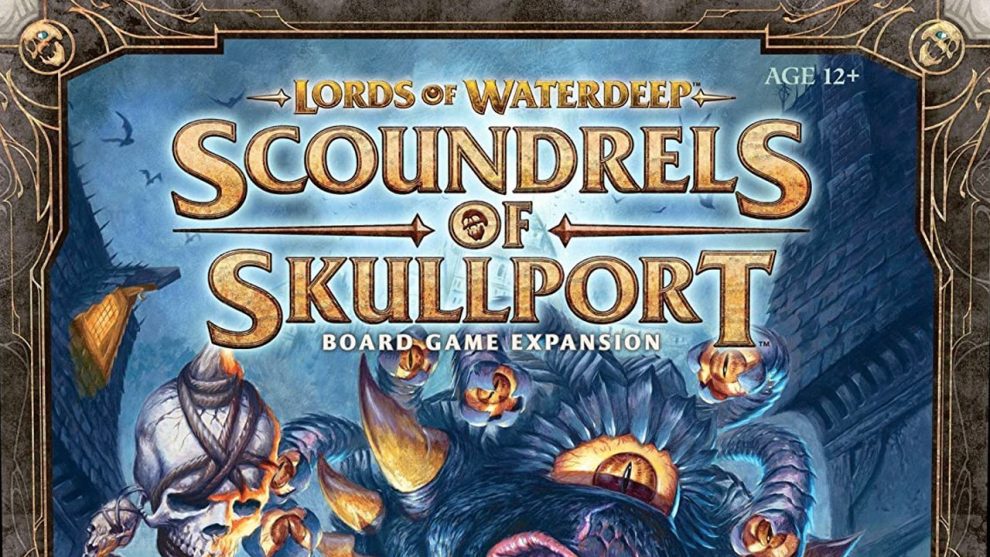









Add Comment